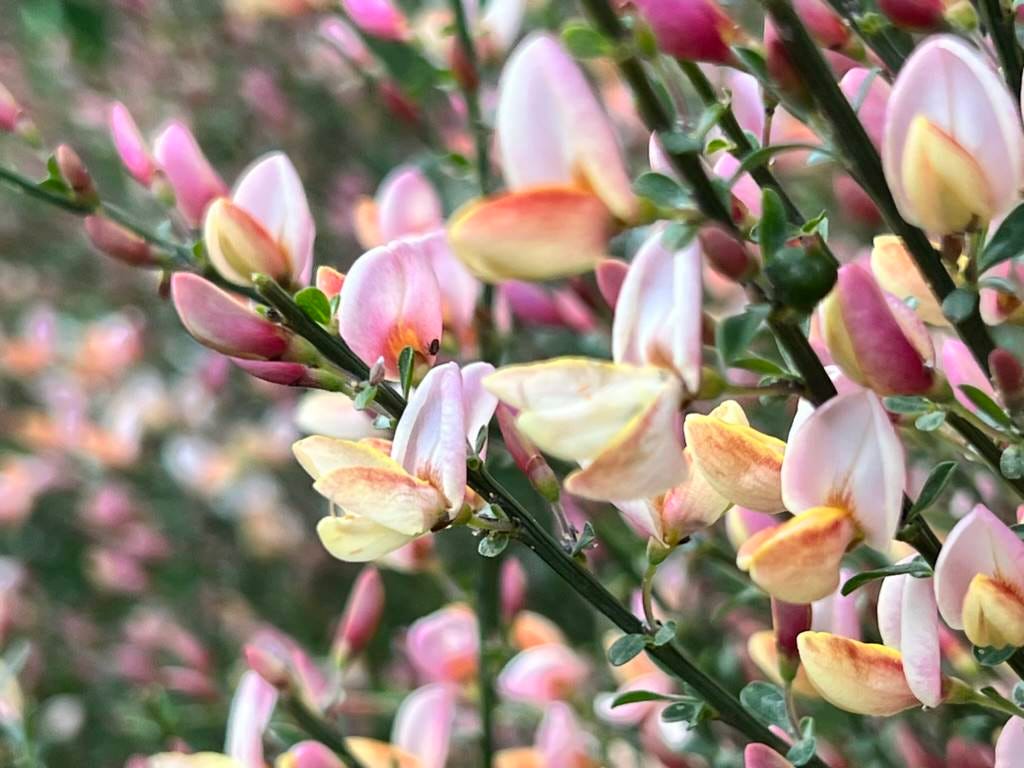Welcome, dear new reader. This is Cloister Notes, an independent letter for dancing monks and weary pilgrims and all kindred souls longing for a deeper way. I am Almut, a German American writer and recovering academic, and mama of a 5 year old, trying to live a life of action and contemplation with my family in a noisy world. Many new readers have found us this week via my post picturing the courageous act of Rep. Al Green. So welcome here at this cloistered space, where we retreat inward to look for solitude and communion to find wisdom and courage within. Today’s Lenten reflection invites you to ponder the sacred in-between places.
Dear fellow pilgrim,
I've never fully identified with either Mary or Martha from the Bible's well-known story1, traditionally read during the second week of Lent. It tells of Mary sitting at Jesus's feet, listening, while Martha works feverishly in the kitchen.
We often feel tempted to identify with one role or the other, don't we? And however we do it, we end up feeling guilty about not being the other.
You might hear yourself asking: Shouldn't I do more instead of sitting here pondering? Or: shouldn't I do more pondering instead of keeping myself busy?
Do these questions sound familiar to you?
The world likes to offer either/or answers, as life seems easier in a binary world.
But, as our pastor did today, I invite you this Lenten season to ponder those in-between spaces, where the sacred waits to meet us.
Last week we spoke about “dancing with our fears,” and maybe entering this in-between space is frightening to some.
But bear with me. As always, a blessing is waiting for you at the end :-)
"Jesus, why don't you tell Mary to get up and help some?" Martha was imploring Jesus.
Jesus looked at her kindly: "You are worried and distracted by many things," he says.
Well, thank you, Martha might think but not say, and who else is supposed to do all the work?
Mary is just sitting at your feet listening; this is not how we get dinner on the table.
When I am Martha, this is what I am thinking often.
But Jesus points something important out. He not only sees Martha's worry and care but also opens her eyes to the importance of what Mary is doing.
Monasteries are great places that teach us to be both Martha and Mary. Monastic life is structured around both action and contemplation—ora et labora, prayer and work.
I remember how I feel when on a private writing retreat at the monastery. The structure between morning prayer, breakfast, writing, noon prayer, lunch, pause, writing, evening prayer, dinner, reading offers me a balance I can rarely achieve at home. And the 5-minute walk from my room to the monastery chapel offers the needed breath of fresh air and physical movement also.
Thus, we often feel so well nurtured retreating into a monastery because their centuries-old wisdom helps us to balance the needs of body, soul, and spirit.
Sister Mary Dolores from St Benedict’s Monastery in MN, the very monastery I often retreat to, has written beautifully about this balance in “Martha and Mary: Archetypes of Integral Discipleship.”
Because looking at Mary and Martha as archetypes helps us see, that each archetype balances and complements the other.2 And it brings awareness to their light and shadow qualities also.
In my conversations with mentees and clients, we often realize the importance of embodying both Martha and Mary to achieve wholeness. While we may naturally align more with one role due to our inherent gifts—a crucial aspect of discerning our vocation—there's a risk in overemphasizing one and neglecting the other.
Every archetype encompasses both—an ideal image we strive toward and a shadow side that emerges upon deeper reflection.
So, here is my archetypal reading of the story:
Martha, embodying the helper archetype, exemplifies the beauty of service and compassion but also carries the shadow of self-annihilation and exhaustion.
Mary, who sits at the feet of Jesus, listening to wisdom incarnate, serves as the necessary counterbalance to achieve equilibrium.
However, Mary's archetype also possesses a shadow side. It can manifest as passivity, detachment, or a retreat from the practicalities of daily life, potentially leading to disengagement from necessary responsibilities.
Still, Mary, is the presence I need during times of service, mothering, or writing.
Mary is the one, who strolls the fields of my childhood, watching the birds build nests and the fiddlehead ferns unfold.
Mary, is the one who actively listens without feeling the urge to jump up and clear the table, or get something more done.
Today's blessing is for all the Marthas—those who care for others and the whole needy world—and who long for a Mary moment:
Dearest Martha,
Blessed be the work of your hands
the work you do
before any one asks
or knows or notices.Blessed are you for
your care and compassion
for the one in need,
even your loved ones.Blessed are you
for your loving kindness
in doing what needs to be done,accommodating
feeding
nursing
cleaning
clothing
the one in need.May you be surprised by wisdom
hiding in your soul
peering out from the bushes
dancing on the dishes
singing with the birds of Spring.Animated by compassion,
May you sit at the feet of Love Eternal.Yours, Mary
With great love, Almut
PS: If you can, leave a heart, a word or a line which resonated with you in the comments, so we know you have been here :-)
Thank you for reading, sharing and supporting Cloister Notes, an independent letter for dancing monks and weary pilgrims to deepen your path and find wisdom with-in. Your support makes this labor of love possible.
If you have been moved by what you are reading, do consider becoming a paid subscriber, joining our intimate communion of fellow pilgrims on the deeper way. As a paid subscriber you have access to our life retreats and seasonal Contemplations, like our upcoming Passion Week Consolation.
You can share this letter by simply forwarding this email, by sharing it on your social networks, or if you are a substacker, by restacking it. Thank you, thank you.
About Cloister Notes
A letter for dancing monks and weary pilgrims in the intersection of psychology, philosophy and spirituality. Contemplations on being human to deepen your path, nourish your heart and build wisdom within.
About Almut
Almut Furchert, Dr. phil., Dipl. Psych. is a German American scholar and practitioner, a psychologist turned philosopher turned writer, traveler, photographer, retreat leader and mother of a kindergartener. She has taught and published on authors like Kierkegaard, Buber, Frankl, Yalom, Edith Stein, and Hildegard of Bingen. Almut is also a Benedictine Oblate and lives with her family in a little college town in MN.
You can manage your subscription here.
In case you missed it
Last Lenten reflection:
The latest “Letter to America” with reading recommendations:
The latest (mid) weekly blessing:
One of my latest notes on substack which kinda went viral:
You can find The story of Martha and Mary in Luke 10:38-42.
Richard Rohr’s Center for Action and Contemplation holds this necessary balance already in its name.











Thank you Almut for another meaningful Sunday blessing. It's very special to receive this blessing at the end of the day as I'm looking to the busy week ahead.
Thank you for this wonderful meditation! I've been thinking about this story since I started writing about medieval contemplatives, because what a particular mystic or movement says about this story reveals a lot about how/where they see God moving in the world. (In 14th century Germany, for instance, there's a tradition of seeing Martha and not Mary as the person to emulate in the story!) I resonate very much with your reading of the story, personally - and I also like to think about 'Mary' and 'Martha' periods of life as a way of deepening my appreciation of where I am, especially when I don't necessarily want to be there. :-)